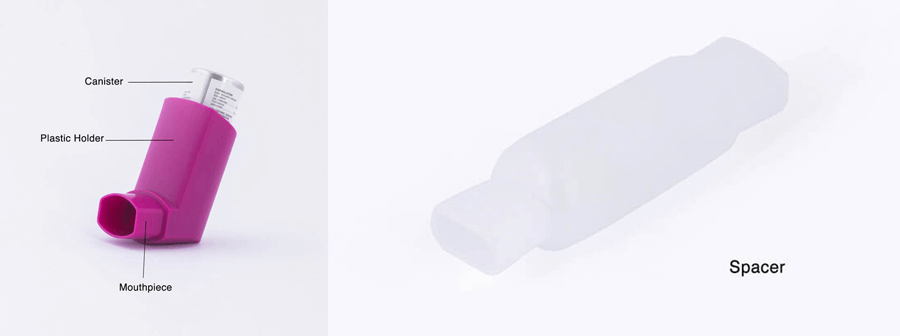

Metered Dose Inhaler
What is a pressurized metered dose inhaler (MDI)?
Metered Dose Inhaler or MDI is a pressurized canister of respiratory medicine in a plastic holder with a mouthpiece. It delivers a measured amount of inhaled medication to the lungs thru spray/puff when breathe in. MDIs use a chemical propellant to produce the spray/puff which carries the measured amount of medicine into the lungs.
MDI is one mode of aerosol drug delivery that is used to treat respiratory disorders such as bronchial asthma, and chronic obstructive pulmonary disease.

Parts of MDI
There are several parts in a Metered Dose Inhaler. The canister, plastic holder, and the mouthpiece. On the other hand, metering valve and propellant with drug suspension can be found inside.
How to use MDI
Getting the inhaler technique right is very important. If you use your MDI the wrong way, less medicine gets into the lungs, hence poor control of symptoms. MDIs require slow, deep inhalation coordinated with actuation – or pressing down the canister one time. It may take a few tries to feel comfortable using the inhaler, but it gets easier with practice.
The common mistake made in using an MDI is not being able to take a breath into your lungs while at the same time, spraying the medicine. As a result, the health care provider may advise to use a spacer (also called a holding chamber).
A spacer holds the puff from the MDI in a tube or “chamber” for a few seconds, so that you don’t have to both breathe in AND spray the MDI at the same time. This helps get more medicine into your lungs and lessens the risk of side effects (such as thrush or hoarseness) by reducing deposition of medicine in the mouth.
Getting ready to use:
Priming
Before using the MDI, priming is needed to make sure the dosing chamber of the MDI fills with the correct amount of medication when you are ready to use the device. You will need to prime the MDI the first time you use a new MDI or if you have not used your inhaler for several days (e.g. 5 days) or weeks.
To prime your MDI, do the following:
- remove the cap of the MDI
- shake the inhaler
- spray it in the air away from you
The number of sprays needed to prime your MDI will depend on the type of medication. The instructions that come with your inhaler tell you how many times the MDI must be primed. Read the instruction for each inhaler carefully because each inhaler may have different priming instructions.
Check expiry date or if empty or nearly empty with dose counter (if it has). There is no reliable way to tell when the inhaler is empty, so patients need to keep a count of doses used and keep a spare inhaler.
Using a MDI without a Spacer
- Hold your inhaler upright with the mouthpiece at the bottom and take the cap off. Check if there’s nothing inside the inhaler mouthpiece.
- Shake the inhaler well.
- Sit or stand up straight and slightly tilt your chin up. Doing this helps the medicine reach the lungs.
The next steps all happen smoothly in one action. - Breathe out gently and slowly away from the inhaler until your lungs feel empty.
- Put the mouthpiece of the inhaler into the mouth past your teeth and above your tongue. Close your lips around the mouthpiece to make a tight seal.
- Start to breathe in slowly and steadily and at the same time, press the canister on the inhaler once. Continue to breathe in slowly and deeply until your lungs feel full.
- Take the inhaler out of your mouth and with your lips closed.
- Hold your breath for up to 10 seconds (to increase deposition of medicine into the airways).
- Then breathe out gently, away from your inhaler.
If you’ve been prescribed a second puff, wait 30 seconds to a minute and shake the inhaler again. Then repeat the steps.
When you have finished, replace the cap on the inhaler. If you’ve used an inhaler that contains steroids, rinse your mouth with water and spit.
Using a MDI with a Spacer
- Hold your inhaler upright with the mouthpiece at the bottom and take the cap off. Check if there’s nothing inside the inhaler mouthpiece.
- Shake the inhaler well.
- Put your inhaler into the hole at the back of the spacer. If your spacer has a valve, make sure the valve is facing upwards. If your spacer has a cap, take it off.
- Sit or stand up straight and slightly tilt your chin up. Doing this helps the medicine reach the lungs.
The next steps all happen smoothly in one action. - Breathe out gently and slowly away from the inhaler until your lungs feel empty.
- Put the mouthpiece of the spacer into the lips and make a tight seal.
- Press the canister on the inhaler once and breathe in slowly and steadily until your lungs feel full.
- Take the mouthpiece of the spacer out of your mouth and with your lips closed.
- Hold your breath for up to 10 seconds (to increase deposition of medicine into the airways).
- Then breathe out gently, away from your inhaler.
*Some small volume spacers make a whistling sound if you’re breathing in too fast.
If you’ve been prescribed a second puff, wait 30 seconds to a minute and shake the inhaler again. Then repeat the steps.
When you’ve finished, take the inhaler out of the spacer and replace the caps on both the inhaler and the spacer (if it has). If you’ve used an inhaler that contains steroids, rinse your mouth with water and spit.
MDI Cleaning and Storage
For most MDIs, remove the canister and rinse the plastic holder with warm running water once a week to prevent the holes from getting clogged. Shake well and let air dry.
There are some MDIs in which the inhaler cannot be removed from the holder. These usually need to be cleaned by wiping the mouthpiece with a cloth or cleaning with a dry cotton swab.
For the spacers, clean them about once a week. Remove the soft ring at the end of the chamber (if it has). Soak the spacer in warm water with a mild detergent/soap. Carefully clean and, rinse, and shake off excess water. Do not hand dry. Allow to completely air dry. Do not store the chamber in a plastic bag.








